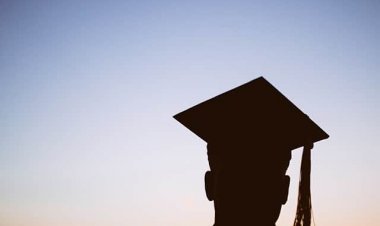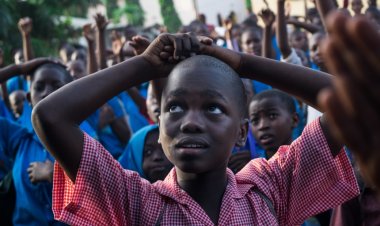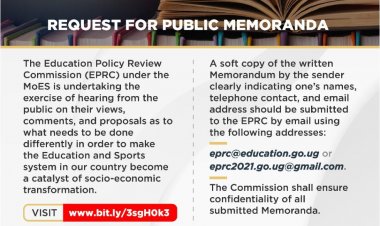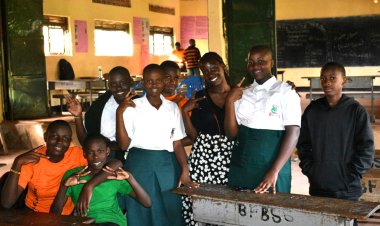PUBLIC MEMORANDA
“MEMORANDUM ON THE PROPOSED STEPS THAT CAN BE TAKEN TO MAKE THE EDUCATION AND SPORTS SYSTEM IN UGANDA BECOME A CATALYST FOR SOCIAL- ECONOMIC TRANSFORMATION”
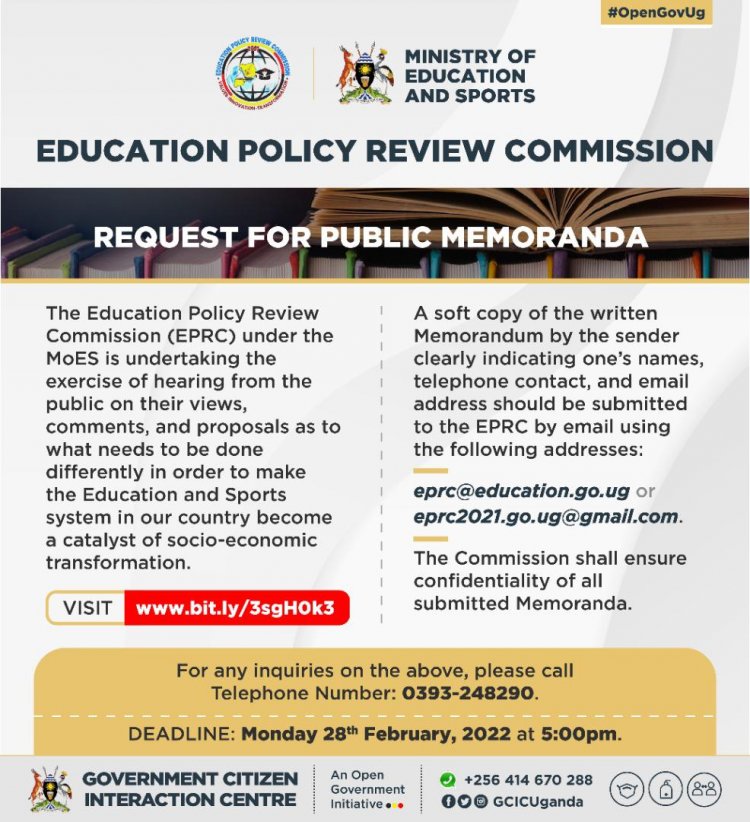
|
Prepared for:- |
EDUCATION POLICY REVIEW COMMISSION |
|
Project Name:- |
MEMORANDUM ON THE PROPOSED STEPS THATCAN BE TAKEN TO MAKE THE EDUCATIONAND SPORTS SYSTEM IN UGANDA BECOME A CATALYST FOR SOCIAL- ECONOMIC TRANSFORMATION |
|
File Reference:- |
NCSA/EPRC/22/IP - 001 |
|
Date:- |
23 February 2022 |
CONTACT INFORMATION;
|
NATIONAL CHRISTIAN STUDENTS ASSOCIATION |
EDUCATION POLICY REVIEW COMMSSION |
|
Plot 4, Luthuli Drive, Bugolobi T/F: +256 756 596001/783 822808 Email: info@oubuntu.co.ug Website: ncsayouth.com |
T/F: +256 393 248290 Email: eprc@education.go.ug / eprc2021.go.ug@gmail.com Website: www.bit.ly/3sgHOk3 |
DOCUMENT CONTROL;
|
ISSUE |
REVISION |
DATE |
AUTHOR INITIALS |
ISSUED TO |
PREPARED BY |
CHECKED BY |
|
|
01 |
00 |
23/02/2022 |
NCSA |
EPRC |
ND , AA |
CN |
|
LIST OF ACRONYMS
In this document unless the context otherwise requires, or other interpretation the several terms, abbreviation, acronyms, and pseudonyms shall have the respective meanings indicated hereunder.
|
EPRC |
Education Policy Review Commission |
|
NCSA |
National Christian Students Association |
|
GDP TVET |
Gross Domestic Product Technical and Vocational Education Training |
1 INTRODUCTION
Basing on the definition of social- economic transformation which is "a process where the major contribution to income, output, employment and gross domestic product of the economy is coming from sectors other than agriculture such as manufacturing, communication technology, capital intensive industries and service sectors."The Education sector is one that can be construed to be at the foundation of all the sectors that make up a country’s economy. The fact that this is so makes it pertinent that the system of education in Uganda directly and constructively feeds into each of the above sectors not only to make them more efficient but also to make the sector directly contribute to the economy. This implies that there is need for adjustment to the education system from the current one that has been effective to an extent but could be improved so that the country and the world benefit more from the products of the system.
The current national education system in Uganda has produced a nexus of people that have profoundly positively contributed to where the nation is at the moment however, over the years due to the technological, social and economic advancements that the world has gone through, there have been noticeable areas that have highlighted the need to improve the education system. This meeting of this need shall ensure that as a nation we not only cope with the change but also be at the forefront of the evolving advancements happening in all the various sectors of our economy. The most pertinent challenges or areas in the current education system that have been observed to need improvement include but are not limited to the following;
- The need to have a more practical based education system as opposed to the current predominantly theoretical system. The current system has led to noticeable difficulty for the learners to put in practice what they have been taught in the class. Which in turn has led to frustration and a slow rate of innovation in all the various sectors when these people reach the employment world.
- The current national education system has also not allowed a broad capitalization on the interests of the learners but has provided a narrow range of options for the learners that has created an excess in supply of people skilled in certain disciplines that is above and beyond the need for them in the market. This has grossly contributed to the increasing the unemployment rate in the country. It has also resulted in unhealthy competition in the employment world for people to be employed in disciplines that they are not interested in but are simply a means to an end. This has led to the clear lack of innovation that the country has experienced overtime and thus affecting the developments made in the country which both directly and indirectly affect the GDP.
- The other challenge of the current national education system is that it does not offer diverse platforms or programs for its scholars to have the ability to evolve into the various career choice opportunities that are available universally. It also has so as to enhance of such as creativity, innovation, critical thinking, persistent problem-solving skills, collaborative working, moral integrity, excellence and social -cultural & spiritual wellbeing of a person as a whole but rather it produces qualification minded students seeking employment. Our current education system mainly uses teacher -centered methods of teaching throughout right from primary education levels to a greater extent even in high levels of learning. This method is much more praised for instilling discipline in learners as its advantage however, it does not promote required basic skills such creative thinking, innovation and research skills in learners when compared to student-centered and project-based learning.
- There has been an inability for the government to provide equitable access to education to bring those that need to attain the education on a leveled ground so as to foster maximization of the resource that the sector is. During the second periodic review, the state of Uganda accepted recommendations for quality and increasing access to education especially for girls, marginalized children, and those living in rural communities. The government of Uganda has continued with the implementation of the Universal Primary and Secondary Education (UPE & USE) Programs. The introduction of UPE and USE has given almost all children the opportunity to access primary and secondary education. For instance, in primary, there has been an increase in enrolment from 8.84million learners in 2017/18 to 10.76million learners in 2019/20 and maintained gender parity with boys and girls at par with 50:50 percentages. Under secondary education, there has been a 45% increment in enrolment from 1.37 million learners in FY2017/18 to 1.99million in 2019/20. The government has implemented UPE and USE programs through construction and grant aiding of community schools. As community schools are required to teach learners without charging school fees. The provision of primary and secondary school at the parish and secondary level has improved access to education but it does not necessarily translate into equitable access to education. Some parishes and sub-counties are either too big or densely populated to be equitably served by one primary or secondary school.
- Inadequate Education Financing Affects the Quality of Education. Since 2016, the government has grant-aided one hundred sixty-seven (167) community secondary schools and 23 primary schools in sub-counties and parishes without USE and UPE schools respectively. In FY2017/18, the government through the Ministry of Education and Sports also commenced the first phase of implementation of the Uganda Government Inter Fiscal Transfer project targeting construction of One Hundred and seventeen (117) new secondary schools in sub-counties without government schools. The UPE and USE schools are operating with a lot of human resource and infrastructural constraints such as classrooms, teacher staff quarters, laboratories, and sanitation facilities. This has led to a high pupil classroom ratio currently standing at. These can be attributed to the low funding of the education sector. In FY2019/20, the education sector share of the national budget was 10.4%, representing 0.68%, from the 11.08% of the FY2018/19 approved budget, the sector expenditure as a percentage of the Gross Domestic Product decreased from 2.78% to 2. 69%. This is 3.31% below the internationally recommended 6%. As a result of the failure to increase funding to education, the school implementing UPE and USE schools are operating with limited funds. This has made education unaffordable for children from poor backgrounds, 67.6% of boys and 64.6% of girls who leave school attribute it to education being expensive and unaffordable and lack of funding to keep them in school.
- The inability to properly regulate the private investors in the education sector. The growing weaknesses in the public education system delivery have given space to the private sector to thrive in the delivery of education. Currently, at the primary level, about 39% of the schools are privately owned, with about 21% enrollment rate of the learners. The private school's share of primary education enrolment has been growing at an average of about 1% per annum over the last ten years. At the secondary level, over 66% of the schools are private and these have been enrolling on average 51% of students. However, the mushrooming of private schools has not been matched with an effective regulatory framework and as a result, the number of private schools has gone beyond the capacity of the education sector to effectively regulate and monitor their operations.
However, these being the most prominent challenges that the NCSA has observed, the following suggestions, solutions and recommendations if adopted shall lead to a more effective and efficient education and sports system. They are premised on developing and training learners to be more willing to learn, to apply what they learn and to also capitalize on development of interest-based learning to produce skill-oriented individuals.
2 NCSA RECOMMENDATIONS AND SOLUTIONS
The following solutions start from early child learning mechanisms, elementary, teenage, adult education to tertiary skill development.
The Ministry of Education and Sports should invest in an intensive mindset charge program(s) in all schools with the aim of orienting learning, promote productivity and increase in spirit of accountability and transparency in the nation.
2.1 Investment and adoption of mindset charge programs and teaching mechanisms
Ministry of Education should invest in an intensive mindset change program(s) in all schools with the aim of orienting learning, promote productivity and increase in spirit of accountability and transparency in the nation. These may take the following forms.
Extensive prior research suggests that mindsets should influence students’ academic success (Dweck, 1999; Yeager et al., 2019). To model the relationship between students’ mindsets and academic experiences, we asked students about their perceived level of success or failure in the course; we termed this variable “failure perception.” When we choose to operationalize students’ academic performance with their perceptions of their performance rather than an objective measure of their actual performance (such as course grades) because students’ subjective perceptions of their academic performance should be more directly relevant to understanding their lived experiences than objective measures of their actual performance. For example, some students may see an average grade (e.g., “C”) as failing to meet their high standards whereas other students may see receiving a passing grade as a success.
2.1.1 Comprehensive training of parents to carryout preschool learning.
Overall research has consistently shown that parental involvement in children’s education does make a positive difference in pupils’ achievement. The two main educators in most children’s’ lives are the parents and teachers. Therefore, children achieve more when parents and teachers work together. This can be done by schools outlining the expectations of parents and regularly communicate with parents about what their children are learning. A successful education system allows and supports engagement of parents in selecting education and learning processes.
Parents are the prime educators until the child attends an early year setting or starts school and they remain a major role player and influence on their child’s learning throughout school and beyond. This kind of comprehensive training basically enables parents understand their role in their children's adaptive stage before they're enrolled in school to give them a better foundation when they begin school. This can be done through training parents in child stimulation.
Child stimulation capitalizes on the child's brain formation and their ability to make mental connections about the things that affect them directly for instance what they see and where it comes from. This enables parents to give children information that feeds their inquisitive nature and helps the child learn about not only the things they see but also where these things spring from. This stimulation process helps in brain child development and by the time a child is enrolled in school they know the basics of how they are connected to the world and how the things they interact with daily root from which in turn gives a better background for all the basic subjects that are taught in school because they'd have been put in context. This would modify and determine what is being taught at the initial stages of school learning for instance in subjects like science.
2.1.2 Introduction of learning through play.
This can be incorporated in the early child education curricula through using fun exciting ways to teach children that enable them learn a wider range of things in a manner that both interests them and enables them retain this information. Especially concerning things that concern them directly like the respiratory system and others of the like.
This entails a diversion from the use of diagrams to explain certain concepts and incorporation of actual making of fun items that represent these organs and allowing children see how they work in a practical and fun way. For instance, an illustration on how the lungs work can be done by use of straws and balloons. This helps a child enjoy the learning process as they make these things and retain the information on how their respiratory system works.
2.2 Introducing practical activities-based learning that stimulates the learners mentally.
These can be tailored to encourage subtle skill giving to children as they learn more about their interests for instance use of play blocks in construction helps children learn more about architecture at a younger age. This not only builds their knowledge on something but also helps them know the practical ways in which their interests work in the real world. This ultimately produces a more innovative set of children because they apply creativity to this practical learning to build onto what is already in existence.
For the later stages of learning this can be done through adopting new teaching methods such as student-centered /constructivist approach and the Project-based learning in order to promote a research culture on the students.
2.3 Effective career guidance.
This is important for the early childhood stages and as a continuous part of the education system at all stages so that children discover their interests and have sufficient knowledge on what those career paths and choices would entail. This can be done by incorporating internship in earlier stages of school like secondary.
Introduction of an internship program that enables students interact with their professions of choice at an earlier stage enables them make more informed decisions about what career paths they would like to undertake and where to focus their energy when it comes to the same. This will produce more intentional learners that are both passionate about what they're doing but are also efficiently skilled because they'll be able to focus their energy where it matters and build onto their knowledge effectively in these areas.
2.4 Encouraging interest-based education.
This can be done through having activities and child monitoring mechanisms that help them discover their interests and develop them from that place right from their young stages.
This can be done through incorporating a wide range of activities both academic and co-curricular to enable effective identification of interests so that children move forward and are taught to capitalize on these strengths to even influence career decisions. This can only be done if there is a system that may be teacher based that pays attention to every child and there is effective monitoring of how these skills are developed. This may also require investment in training by schools and parents. This can be best affected by having continuous assessment that pays attention to all the skills and specific interests that are the desired learning objectives for a particular group. This can be more efficient than the test-based assessment system that only test’s ability to retain information that the current education system uses.2.5 Focus on vocational or practical learning.
As has already been adopted in the new syllabus for secondary, this could be incorporated in the earlier stages of learning like primary schools. It will enable students have a better understanding of how the subjects they're learning apply to them in the real world and help them retain Information better but mostly be able to practice, apply and even use this information to make developments and discoveries in those areas. This can be done by including in the upper secondary education /Advanced level (S.5 & S.6) T\technical and vocational education training (TVET), Science and technology Academies and sports Academies.
2.6 Set higher standards for investors in the education sector and ensure or put in place mechanisms that ensure effective management of quality control.
The government should take all necessary measures to regulate the private educational sector by monitoring their compliance with education standards and reviewing and amending if necessary its laws and policies governing private education providers.
This would entail the ministry coming up with specific criteria for investors in the education system to provide specific learning environments that are conducive for developing and exposing students to all career options. Putting in place institutions that can provide a wide range of subjects that are both practical and theoretical hence not limiting a child's exposure and learning to the financial constraints of the institution but giving them an opportunity to make informed decisions about their career paths since they've been exposed to a significant amount of potential career options through a wide range of subjects.
Having the Ministry of education outsource a private entity or body to manage the running of all public schools on a limited time period contract basis to enable that quality control standards are both managed and upheld.
The policies and programs in the education structure should aim at higher achievement standards that establish uniform education criteria, methods, processes and practices developed through an accredited consensus process. These standards should be developed based on guiding principles of openness, balance, consensus and due process. They should further be put in place in order to meet technical, safety, regulatory, societal and market needs and should be a catalyst for technological innovation and global market competition. This will ensure that the system is actually beneficial to the needs of the country and the world at large.
The adoption of standards benefits both the students and their teachers of lecturers because this will help in managing student records, research proposals and output, using classroom interaction technology, supporting flexible learning like online learning, providing authentication and authorization services for managing access to digital resources and using digital assessments which will all provide a uniform management and control system hence make evaluation and accountability in the education system better.
2.7 Adoption of use of technology in the education system.
Intelligent use of technology should be used to transform and improve the child’s learning experience by giving them more exposure beyond their physical communities and access to both practical and more data informed learning. This basically will enable students learn to apply whatever they learn to the practical world and inspire them to not only apply but contribute to development and change in the areas that they have had exposure to due to the use of technology.
A 2016 UNESCO study indicated that only one out of 10 learners in Uganda accesses basic quality education. While many learners would love to access wholesome education few have the necessary equipment and devices to be able to do this. Therefore, adoption of digital media platforms (social network) for students and trainers in university, tertiary institutions, secondary, pre‐ and primary schools to learn/train, mentor and share in academic, social and extracurricular activities of their interest, and to especially share and access digital academic materials in multimedia formats, whether text, audio or audio‐visual/video, as well as hold or attend classes.
2.8 The Ministry of Education and Sports with the assistance of other government agencies should undertake studies to ascertain and establish the unit cost required to educate a child all through their compulsory academic life which is in both primary and secondary schools.
This will enable proper, efficient and effective funding to be done on so that the necessary results that the sector intends to achieve are arrived at and that there is proper accountability at each stage to show the results of the various implementations. Uganda received recommendations on education. This will further foster a good student teacher ratio so that each student and pupil is being effectively handled.
2.9 The government should increase financial investment in the public education sector.
This can be achieved by allocating a bigger percentage of the budget to education and prioritizing funding for basic education. and also he unregulated private sector in education. The government should focus on increasing capitation grants and this can be done through carrying out initiatives such as this one to properly assess where the system is lacking and ideas on what can be done to better the system so that there is follow up and accountability at each state to encourage those giving grants to the sector since there is progress.
2.10 Increase in accessibility to financial aid through student loan schemes
The government should allow accessibility for financial aid through student loan schemes for learners from low income backgrounds especially for students in higher in situations of learning like university. Making these loan schemes more accessible will increase and improve the quality of education one can acquire for themselves without necessarily having to afford it. This would require an open door policy where all students can apply for these loan schemes. This shall create a strong incentive on the part of public institutions and government to modify and improve the university curriculum to better position students to succeed in life out of university as the incentive to lessen the potential for defaulting on the same and it will operate as a spark for improving on the relevancy of higher education. This shall ensure that all beneficiaries are weighted on a similar standard.
2.11 The creation of a student employment bureau.
This would be a place where students work for pay in the form of tuition waivers. This would allow students the opportunity to benefit from the establishment of an employment bureau as they would not only exercise their learned skills, but they would also receive some payment in turn which would be used to cater for their needs and tuition costs. This could work best in both public and private institutions where these institutions allow students in higher institutions of learning to not only be able to afford their education but to also make their skills more practical and enable them be more focused to develop and apply whatever they are studying. This will eventually allow the youth to be more efficient in the communities that they belong to as well.
2.12 Implementation of faith based education.
A well-taught faith based education will give students a broader, healthier perspective on life than their peers. A worldview that is based on Biblical principles will be one of selflessness, acceptance, and love for their fellow man. As articulated by the Notre Dame School in the UK, “In a school that offers a Christian education the principles of welcome, nurture and compassion should be evident as you walk through the door. This is part of the mission of faith based schools, where all are welcome, and encompasses an ethos that stretches throughout the world, because faith organisations seek to bring stability and compassion into an uncertain world.” Students whose education is built on the teachings of Jesus Christ will not grow up into self-centered, ethno-centric adults. Quite the contrary. They will grow into a loving force for the greater good of mankind.
In a report published by USA Today, they found: “in 12 studies over the past 15 years that relied on the research method of random assignment, 11 showed that students using vouchers to attend private and faith-based schools had higher reading and math scores and higher graduation rates and college attendance than students who remained in their public schools.” The correlation between a faith based education and long-term academic success is a strong one. The Council for American Private Education (CAPE) stated, “Students in religious schools enjoy a significant academic advantage over their counterparts in traditional public schools and charter schools, according to findings from a meta-analysis of 90 studies on the effects of schools conducted by William Jeynes, senior fellow at the Witherspoon Institute in Princeton, New Jersey, and a professor at California State University, Long Beach. The study was published in issue 3 of volume 87 of the Peabody Journal of Education. “The results indicate that attending private religious schools is associated with the highest level of academic achievement among the three school types, even when sophisticated controls are used to adjust for socioeconomic status.’ This shows that implementation of faith based learning produces more functional students and adults who are in a better position to positively impact the world.
3 CONCLUSION
In conclusion, we strongly recommend that the Ministry of Education and Sports should adopt the above suggestions in order to make education and sports a catalyst of social-economic transformation. The implementation of these policy reforms should be a collaborative effort of the Government under the ministry of education, the private sector and both religious and cultural leadership in this country especially in mindset change. The above-mentioned education policy reforms are vivid and will make the Education and sports system in Uganda become a catalyst for social-economic transformation when adopted.
4 REFERENCES
- 2022, https://www.igi-global.com/dictionary/socio-economic-transformation-set/83451
- 2022,https://www.technofunc.com/index.php/domain-knowledge/education-domain/item/how-to-improve-educatio-system
- Dweck, C. S. (1999). Self-theories: Their role in motivation, personality, and development. New York: Psychology Press.
- 2022, https://fredericksburgchristian.com/2017/09/08/benefits-faith-based-education/
- 2022, https://www.technofunc.com/index.php/domain-knowledge/education-domain/item/how-to-improve-education-system
- 2022,https://www.iser-uganda.org/publications/reports/539-the-state-of-economic,-social-and-cultural-rights-in-uganda-and-emerging-issues-a-joint-submission-to-the-united-nations-universal-periodic-review-upr-of-uganda
- https://www.iser-uganda.org/publications/reports/540-covid-19-and-economic-social-rights-in-uganda-iser-s-submission-to-the-united-nations-universal-periodic-review-upr-of-uganda
- https://www.cia.gov/library/publications/the-world-factbook/geos/ug.html; Conan Businge, Universities: Student drop-out rates alarming
- https://www.newvision.co.ug/news/1502587/universities-student-drop-rates-alarming ; Funding Higher Education in Uganda in an Era of Growth. Pg 9. The fact that Uganda’s tuition was 20% lower than Tanzania and Kenya.;
- The 2008/2009 Ministerial Policy Statement requiring 50% contribution by public universities towards their maintenance. Non-Tax revenue is principally revenue from tuition, but also includes sales of ancillary services. **excluding Busitema Source:
- 2008/09 Ministerial Policy Statement; State of Higher Education and Training in Uganda 2006; Aguti, J. et al. “Determinants of Student Dropout from Two External Degree Programmes of Makerere University, Kampala, Uganda.” (2009).; Universities: Student drop-out rates alarming; https://www.newvision.co.ug/news/1502587/universities-student-drop-rates-alarming
- World bank (2019), Poverty headcount ratio at national poverty lines (% of population) - Uganda, available on: https://data.worldbank.org/indicator/SI.POV.NAHC?locations=UG[08 November 2020]
|
PREPARED BY: |
Nakitende Deborah and Allan Alyon
MEMBERS OF THE NATIONAL CHRISTIAN STUDENTS ASSOCIATION |
Signature:
Date; |
23 February 2022 |
|
APPROVED BY: |
Ssenyonga Simon
DIRECTOR, NCSA |
Signature:
Date; |
23 February 2022 |














